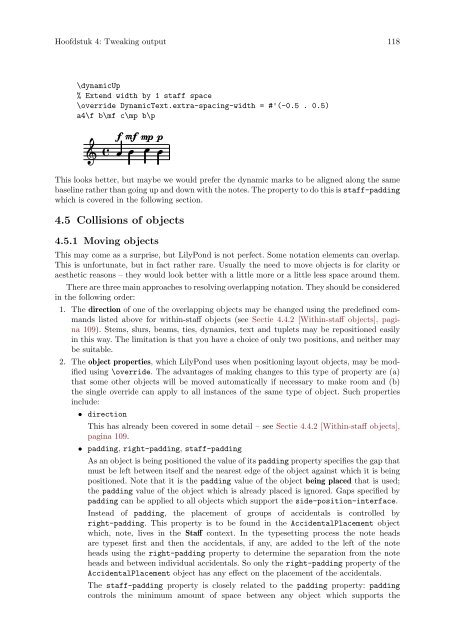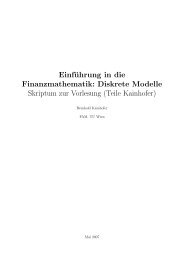LilyPond Beginnershandleiding
LilyPond Beginnershandleiding
LilyPond Beginnershandleiding
You also want an ePaper? Increase the reach of your titles
YUMPU automatically turns print PDFs into web optimized ePapers that Google loves.
Hoofdstuk 4: Tweaking output 118<br />
\dynamicUp<br />
% Extend width by 1 staff space<br />
\override DynamicText.extra-spacing-width = #'(-0.5 . 0.5)<br />
a4\f b\mf c\mp b\p<br />
<br />
f<br />
mf<br />
mp p<br />
<br />
This looks better, but maybe we would prefer the dynamic marks to be aligned along the same<br />
baseline rather than going up and down with the notes. The property to do this is staff-padding<br />
which is covered in the following section.<br />
4.5 Collisions of objects<br />
4.5.1 Moving objects<br />
This may come as a surprise, but <strong>LilyPond</strong> is not perfect. Some notation elements can overlap.<br />
This is unfortunate, but in fact rather rare. Usually the need to move objects is for clarity or<br />
aesthetic reasons – they would look better with a little more or a little less space around them.<br />
There are three main approaches to resolving overlapping notation. They should be considered<br />
in the following order:<br />
1. The direction of one of the overlapping objects may be changed using the predefined commands<br />
listed above for within-staff objects (see Sectie 4.4.2 [Within-staff objects], pagina<br />
109). Stems, slurs, beams, ties, dynamics, text and tuplets may be repositioned easily<br />
in this way. The limitation is that you have a choice of only two positions, and neither may<br />
be suitable.<br />
2. The object properties, which <strong>LilyPond</strong> uses when positioning layout objects, may be modified<br />
using \override. The advantages of making changes to this type of property are (a)<br />
that some other objects will be moved automatically if necessary to make room and (b)<br />
the single override can apply to all instances of the same type of object. Such properties<br />
include:<br />
• direction<br />
This has already been covered in some detail – see Sectie 4.4.2 [Within-staff objects],<br />
pagina 109.<br />
• padding, right-padding, staff-padding<br />
As an object is being positioned the value of its padding property specifies the gap that<br />
must be left between itself and the nearest edge of the object against which it is being<br />
positioned. Note that it is the padding value of the object being placed that is used;<br />
the padding value of the object which is already placed is ignored. Gaps specified by<br />
padding can be applied to all objects which support the side-position-interface.<br />
Instead of padding, the placement of groups of accidentals is controlled by<br />
right-padding. This property is to be found in the AccidentalPlacement object<br />
which, note, lives in the Staff context. In the typesetting process the note heads<br />
are typeset first and then the accidentals, if any, are added to the left of the note<br />
heads using the right-padding property to determine the separation from the note<br />
heads and between individual accidentals. So only the right-padding property of the<br />
AccidentalPlacement object has any effect on the placement of the accidentals.<br />
The staff-padding property is closely related to the padding property: padding<br />
controls the minimum amount of space between any object which supports the



